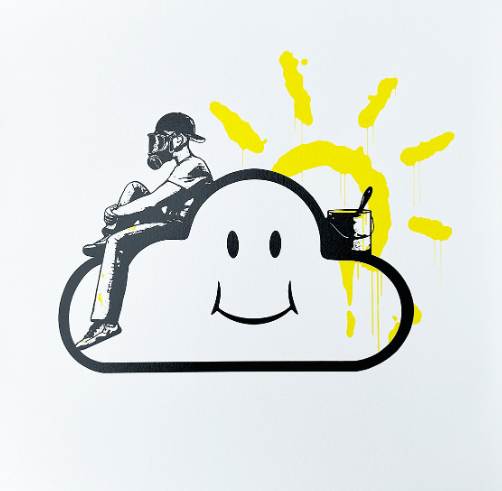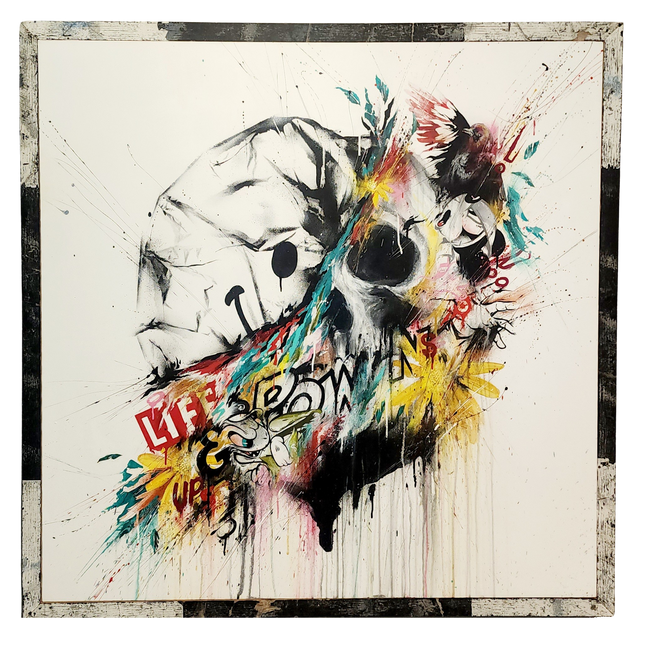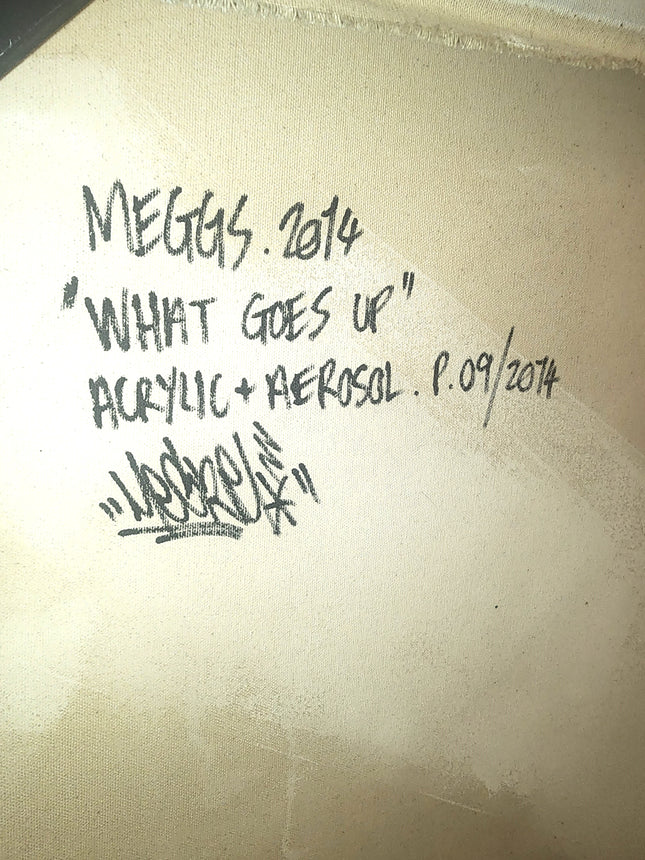
Smile


Meggs What Goes Up Original Spray Paint Acrylic Painting by Meggs
What Goes Up Original Spray Paint Acrylic Painting by Meggs One of a Kind Artwork on Canvas with Custom Reclaimed Wood Frame by Street Art Pop Artist. 2014 Signed Acrylic & Spray Paint Painting Original Canvas in Artist Hand Made Reclaimed Wood Frame Artwork Size 49x49. From Spoiled Rotten Show. Exploring the Dynamic Essence of Meggs' "What Goes Up" "What Goes Up" is an original acrylic and spray paint painting by the acclaimed street pop artist Meggs that encapsulates the dynamism and energy of his work. Created in 2014, this artwork reflects Meggs' signature style, which harmoniously blends street art's rawness with pop art's vividness. This one-of-a-kind artwork is a statement piece and a storytelling canvas that explores themes prevalent in Meggs' oeuvre, such as the constant struggle between opposing forces and the transient nature of success and failure. The painting measures 46x46 inches and is housed in a custom reclaimed wood frame handcrafted by the artist. Reclaimed wood adds an eco-conscious dimension to the artwork, reinforcing Meggs' interest in sustainability and the repurposing of materials. This choice of framing also accentuates the urban and gritty feel of the painting, resonating with the street art tradition of using found objects and spaces. Artistic Techniques and Visual Impact in "What Goes Up" Meggs employs acrylic and spray paint in "What Goes Up," showcasing his adeptness at using traditional and non-traditional media. The acrylic provides depth and texture, while the spray paint offers a sense of immediacy and spontaneity intrinsic to graffiti artwork. The painting is a cacophony of colors, bursting forth from a central point, suggesting an explosion of energy and creativity. The colors are not just randomly splashed across the canvas; they are meticulously layered to create a visual impact that is both chaotic and controlled. The artwork features a skull motif, a recurring element in Meggs' art, which often symbolizes the transient nature of human existence and the cyclical nature of life. However, in "What Goes Up," the skull is juxtaposed with vibrant colors and comic-style exclamations, which could be interpreted as a commentary on the superficiality of popular culture and the fleeting nature of fame and success. The skull seems to be disintegrating or exploding into an array of colors and shapes, a powerful visual metaphor for the inevitable downfall that follows a rise to the top. Cultural Commentary and the Essence of Street Pop Art The painting's title, "What Goes Up," hints at the adage "what goes up must come down," suggesting a narrative of ascent and descent. Meggs often infuses his Street Pop Art and graffiti Artwork with philosophical musings and critical observations of society. The work symbolizes the cyclical patterns of life and can be seen as a reflection of the transient nature of success or the hubris that often precedes a fall. The artist's use of text in the painting, rendered in a comic book style, adds a layer of communication with the viewer, inviting them to ponder the deeper meanings behind the vibrant facade. The piece is a testament to the artist's ability to navigate the space between gallery and street art, making it accessible to a diverse audience. The inclusivity of street art is evident in Meggs' work, where the public space becomes a canvas for dialogue, and the art becomes a part of the everyday urban landscape. "What Goes Up" is not just a visual spectacle but also a piece of cultural commentary, encapsulating the ethos of street art and its role in contemporary discourse. "What Goes Up" is a prime example of Meggs' impact on the field of street art and his contribution to the broader pop art movement. The painting manifests the artist's dedication to craft, concept, and commentary. Through the integration of various artistic techniques and the strategic use of reclaimed materials, Meggs has created an artwork that is both a visual feast and a conceptual powerhouse. The significance of Meggs' work lies in its ability to resonate with viewers on multiple levels. This work can be appreciated for its aesthetic qualities and ability to evoke emotion and provoke thought. As a piece of Street Pop Art and graffiti Artwork, "What Goes Up" embodies the spirit of this genre, which continues to push the boundaries of art and its place in society. It remains a poignant piece within Meggs' body of work and within the larger conversation of contemporary art.
$10,000.00



